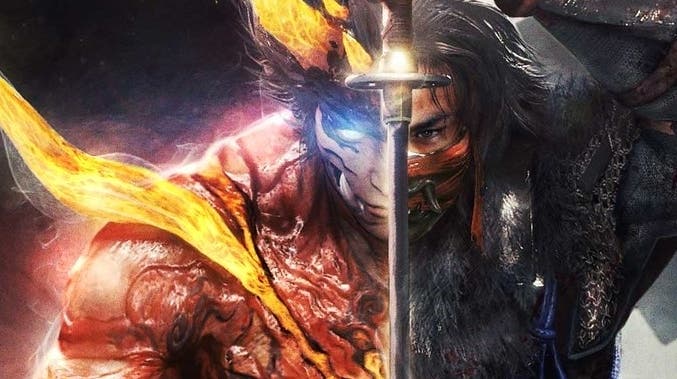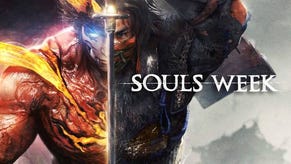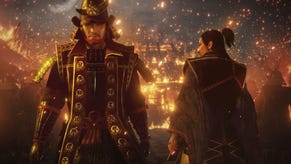Nioh 2 review - a vast and engrossing if dutiful follow-up to a landmark Soulslike
Shouldering the Yokai.
The measure of a good Soulslike isn't the might of its (Nameless) kings, but the deviousness of its pawns. Marquee adversaries like Ornstein and Smough might command the lion's share of Youtube uploads, but they aren't, or shouldn't be, the things you truly dread. Nioh 2 offers plenty of bosses, most plucked from the grottier tracts of Japanese folklore and all endowed with the ability to shift the proceedings into the "yokai" or spirit realm, where their attacks are more ferocious - a nifty variation on the idea of boss phases. My standouts include a massive owl demon who periodically turns off the lights, forcing you to track the creature by its glaring red eyes. But this terrific, if conservative and overloaded follow-up to 2017's blend of Ninja Gaiden and Dark Souls isn't really about the giants. It's about the dirty little bastards in the undergrowth, the rank-and-file grunts with tricks up their sleeves.
For instance: you'll meet a demon hag whose abilities include a sort of arthritic spin attack, cackling and flailing around as though trying to free herself from a net. It's easily evaded and rather silly, more senior moment than special move. Often, it ends with the hag tumbling over in a heap. But sometimes, it ends with her bowling a knife at your head. Elsewhere you'll encounter bandits who are easy prey till they're about to die, whereupon they'll Hulk out and wrestle you to the floor, and deceptively polished samurai who are host to demons that spit fire and poison.
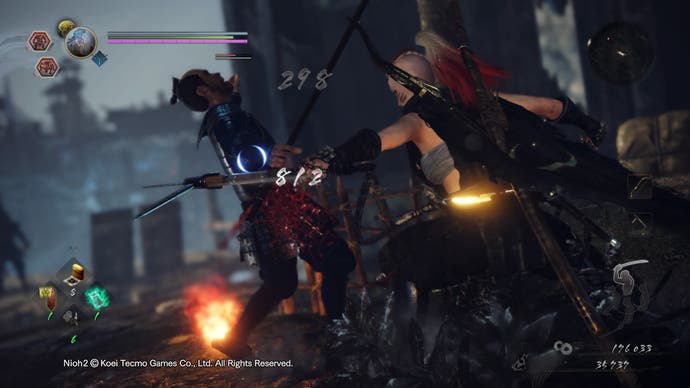
Worst of all, though, are the pot-bellied Gollum equivalents who infest the game's Sengoku Japan setting, a world of cherry-blossom villages, spoiling castles and torchlit carrion fields. It's not just that they're fond of playing dead near treasure. It's not just that they spew paralysing fluid when you punch them too hard, or that they sometimes accompany larger threats - bouncing stones off your skull like unruly children as you duck under blows that will kill you instantly. It's that when you knock one flat, another may pounce on and devour it, tripling in size. You skitter out of reach, and whoops, it turns out one of those hags was lurking in a closet behind you. These are the reversals that really set Soulslikes apart, the moments when no amount of levelling, gear bonuses, abject pleading or apoplectic rage can stop you dying at the hands of the very first enemy type you killed, 40 hours before.
If Nioh 2 is full of such surprises, it is not a surprising sequel. Branding it Nioh 1.5 is too much, but this is definitely a case of ornamenting the grip rather than changing the blade (forgery nerds, feel free to chime in here with a more apposite comparison). Set before the first game's events, it casts you as Hide, a custom-created adventurer with yokai blood - a trait that allows you to wield the abilities of slain demons and briefly assume yokai form yourself. Early on you fall in with a wandering ragamuffin, Tokichiro, who embroils you in a quest for fame and fortune.
The gimmick is that you're enacting the secret history of Toyotomi Hideyoshi, the real-life daimyo credited with unifying a wartorn Japan, who in this retelling was actually two people. The real Hideyoshi's feats include confiscating swords from all over Japan and melting them down into a statue of the Buddha - a source of some irony here, given that you'll spend much of Nioh 2 wondering how to dispose of all the worn-out gear filling your inventory. The first game was hardly feted for its storytelling and the second offers much the same, lavish but scatter-brained mix of period celebrities, eccentrics and pantomime manipulators. The dialogue and acting are sparky, but there's little narrative backbone. Ultimately, it's just a bunch of interludes stuffed into a campaign where you pick main and side missions from a Total War-style overworld view.
Returning players will find Nioh 2 looks and handles mostly as was, give or take some more lifelike animations and a richer colour palette. From Souls, Nioh derives the idea of dropping your collected XP at the point of death, granting you a single opportunity to recover it, together with moody, winding levels pegged together by shrines full of friendly sprites who restore you while also resurrecting non-boss enemies. Unlike in Souls, these are separately loaded areas, but they're governed by a similar emphasis on unlockable shortcuts. Most consist of three or four shrines positioned near doors that must be opened from the other side, once you've fought your way round to it. The major geographical change-ups over Nioh are dark zones where the border between mortal and yokai realm has collapsed. Shrines and treasure chests are off limits, here, till you've purged the midboss responsible for the psychic overspill.

To Ninja Gaiden, meanwhile, the game owes its elaborate melee combat system, with dozens upon dozens of weapon-specific combos backed up by ninja tools such as poisoned shuriken, Onmyo spells such as fireballs or lifesteal, and the nuclear options conferred by your character's Guardian Spirit. Of the weapon types - axe, katana, dual blades, switchglaive, spear, odachi, tonfas, kusarigama, hatchets, switchglaive - only the last two are new, and the remainder recycle most of their combos, parries and specials from the first game. Each weapon can be wielded in three stances with diverging movesets: high stance trades speed for power, low stance power for speed, and middle is... in the middle.
The supporting role-playing systems are essentially as before but with a lot more meat on them. Besides spending "amrita" or XP to level up stats that correspond to weapon types, and allocating points to each weapon category's sprawling unlock tree, you build Familiarity with individual weapons that lets you deal more damage with them. This encourages you to master each one, rather than casting it aside the second you find a rarer specimen with higher base capabilities - which in my experience, happens roughly every couple of minutes. To all that, add armour effects like health regen when you imbue your attacks with the water element, together with the bonuses afforded by your choice of Guardian spirit. It's a lot to swallow, and that's before you start combining and forging your own equipment between missions, transferring bonuses to higher-level blades or dismantling them for parts.
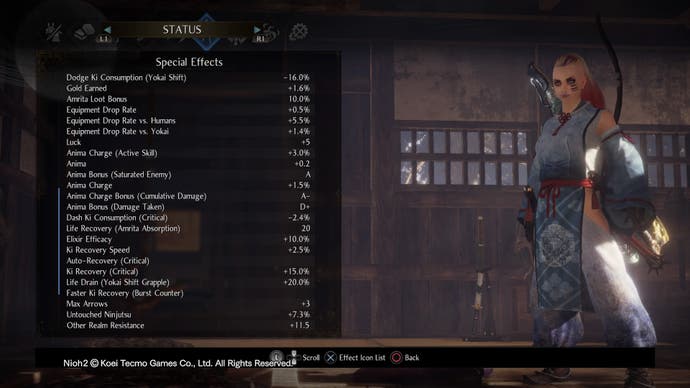
A role-player this top-heavy needs something to catalyse the emotions in the moment. That thing is once again Nioh's clever redefinition of stamina as "ki", the all-pervading vital energy from Japanese martial arts. Swing a weapon and you'll scatter ki into the air, like sparks from a torch. Exhaust the bar and you'll be unable to perform any action at all, not even the sagging blows that result when you empty the tank in the Souls games. Take a hit in this state and you'll be stunned for a good couple of seconds, opportunity enough for pretty much any opponent to finish you off. So you do your best to keep the bar full - not just retreating and dropping your guard to regain poise, but tapping R1 as ki leaves your body to suck it back in.
Doing this also dispels puddles of ki-sapping static conjured by demons - bosses, especially, slop this vampiric substance all over, forcing you to nail those pulses or stick to uncontaminated areas. Ki restoration isn't as all-important as it may sound, or as tricky to pull off - if you're struggling to stir it into your combos, there are unlocks that trigger ki pulses when you dodge or perform other routine actions. But the system gives your presence in this world a certain poetic charge. It's not just about catching your breath so that you can clobber somebody with your axe, but aligning inner and outer equilibriums, becoming one with your environment - and clobbering somebody with your axe while you're at it.
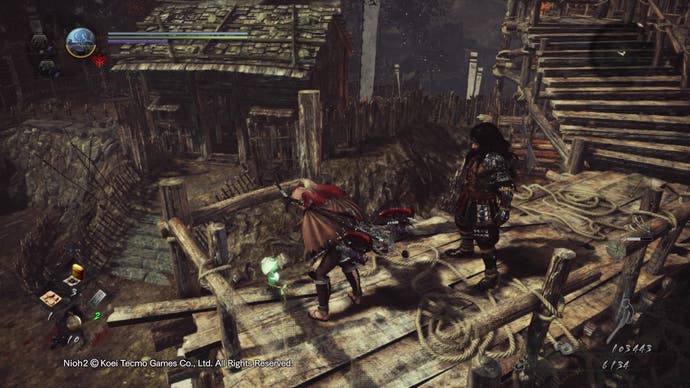
The weapons themselves are a joy to wield, whether you're crushing enemies into the floor with the odachi's 12-foot blade or wrapping them in the kusarigama's chain. The new toys aren't transformative but have their share of lethal quirks: the hatchets can be thrown, returning to your hands by magic, while the switchglaive (a nod to Bloodborne) unfolds from a rapid-slicing razor into a sweeping polearm and a scythe for messy finishers. I'm less convinced by the new yokai abilities, which are equipped by plugging cores dropped by demons into your Guardian spirit. The possibilities range from yanking an enormous flaming hammer out of your backpocket, to bursting through the ground as a legless ogre.
They're good fun visually, but some are much more useful than others, and their tactical applications are blunt - either dealing a ton of damage at once or trying to stagger a foe (or both). Demon cores also add to the pressure on your inventory, which frequently saw me dumping helmets and cuirasses by the roadside (a less wasteful way of shedding weight is to trade weapons for currency at shrines). I also have mixed feelings about the new yokai transformations, which replace Nioh's Living Weapons. Each of the three yokai forms has its own weapons, moveset and a "Burst" counter for use against more devastating attacks that are pre-empted by a boiling red glow. There's another layer of skill here, but I mostly used transformations to spam my way out of corners or finish bosses I couldn't be bothered to murder scientifically.
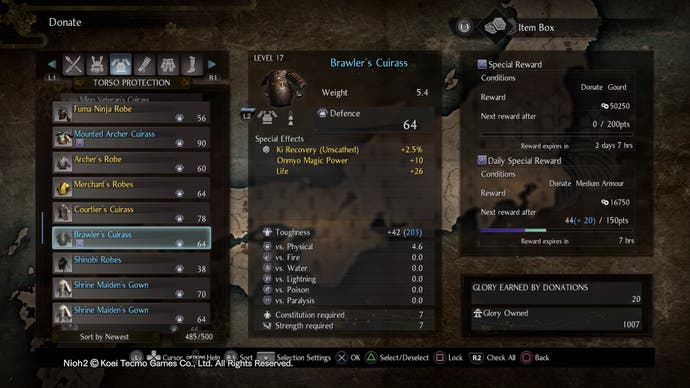
In general I feel like Nioh 2 is rather bloated, a feeling that intensifies over the course of the game as you spend less time clashing with monsters and more time taming the hydra-headed spreadsheet equation that is character customisation. I was dismayed to find, 30 hours in, that I'd unlocked yet another layer - one of those abstract "clan battle" modes where you join and donate items to a faction in return for passive bonuses. A man may tire of passive bonuses, even when he's not on deadline. More controversially, this feature seems to have taken the place of regular PvP, though this is made up for by the expanded co-op options. (Update: as a reader points out, the clan battle mechanic was in the original game too, with PvP coming later via DLC.) You can now summon the AI-controlled shades of other players as both opponents and allies - handy indeed when there's nobody online to help you through a bossfight, though the AI is too inept to serve as more than a distraction.
The more you play, too, the more you notice the project management that structures the levels. Each has its guiding conceit, such as a central elevator or a network of dams that expose patches of loot-rich riverbed when lowered. But the cadence of shrines and shortcuts, optional areas and boss chambers is the same throughout, which slowly erodes the curiosity generated by the game's otherwise absorbing architecture. In Dark Souls, the world is an interlocking, eldritch conundrum. In Nioh 2, it's a series of fiendish puzzle boxes. Engrossing and oppressive, for sure, but not that startling or intriguing.
Hence, perhaps, my delight when some grubby spearman in home-made armour catches me off guard. It's the dose of adrenaline an oversaturated game needs, like discovering a razor blade inside your seventh slice of wedding cake. Nioh 2 is a work of immense skill and scale, but Team Ninja's next project needs to be more about changing things than adding them. After all, no amount of equipment buffs can protect you against the element of surprise.
